Ionospheric TEC Prediction in China during Storm Periods Based on Deep Learning: Mixed CNN-BiLSTM Method
Abstract
:1. Introduction
2. Data and Methods
2.1. Ionospheric Data and Related Indices
2.2. Data Normalization
2.3. Mixed CNN-BiLSTM
2.4. SHAP Value
2.5. Definition of an Ionospheric Storm Event
2.6. Evaluation Metrics
3. Results and Discussion
3.1. SHAP Value Analysis of the Model
3.2. Case Analysis of Predictive Performance during Magnetic Storm
3.3. Evaluation of Model Accuracy
4. Conclusions
- According to the computed SHAP values during the model construction process, it is evident that historical TEC maps make the primary contribution to the prediction process. The contributions of F10.7, Kp, ap, AE, and the time factor follow next in significance, while the contributions of DI and Dst are minimal but still play a necessary role in improving accuracy. As the predicted length increases, the SHAP values of TEC maps gradually decrease, while the SHAP values of other features progressively increase. This indicates the indispensable roles played by the geomagnetic index, solar activity index, time factor, and DI in long-term predictions.
- Through the analysis of the prediction results, it is evident that the model performs well in short-term forecasts, accurately predicting the occurrence of ionospheric storms, the magnitude of disturbances, and their evolution. However, as the predicted length increases, the prediction accuracy of the model gradually decreases, and there may be a small number of incorrect predictions. Nevertheless, even with some errors, the model is still capable of capturing the entire process of ionospheric storms in the majority of events.
- When classifying ionospheric storms, the model may encounter classification errors in the initial stage of disturbances during short-term forecasts. However, it demonstrates accurate classification at other time points. In long-term predictions, although some errors may occur in the forecast results, they are primarily due to inaccuracies in predicting the magnitude of disturbances. Nonetheless, the overall trends and evolution processes are correctly identified by the model.
- In the prediction results, the relative error in the northeast region is higher compared to the southwest region, while the absolute error is not significant. In terms of classification evaluation, the northern region exhibits lower accuracy but higher F1 scores compared to the southern region. These differences may be attributed to variations in the occurrence rate and magnitude of ionospheric storms among different regions. The northeast region experiences a higher occurrence rate of negative storms and stronger disturbances, whereas the opposite is true for the southwest region. These factors could contribute to the varying prediction performance of the model in different regions.
Author Contributions
Funding
Data Availability Statement
Acknowledgments
Conflicts of Interest
References
- Basu, S.; Basu, S.; MacKenzie, E.; Coley, W.R.; Sharber, J.R.; Hoegy, W.R. Plasma structuring by the gradient drift instability at high latitudes and comparison with velocity shear driven processes. J. Geophys. Res. Space Phys. 2012, 95, 7799–7818. [Google Scholar] [CrossRef]
- Jakowski, N.; Béniguel, Y.; De Franceschi, G.; Pajares, M.H.; Jacobsen, K.S.; Stanislawska, I.; Tomasik, L.; Warnant, R.; Wautelet, G. Monitoring, tracking and forecasting ionospheric perturbations using GNSS techniques. J. Space Weather Space Clim. 2012, 2, A22. [Google Scholar] [CrossRef]
- Klobuchar, J.A. Ionospheric time-delay algorithm for single-frequency GPS users. IEEE Trans. Aerosp. Electron. Syst. 1987, 3, 325–331. [Google Scholar] [CrossRef]
- Prieto-Cerdeira, R.; Orús-Pérez, R.; Breeuwer, E.; Lucas-Rodriguez, R.; Falcone, M. Performance of the Galileo Single-Frequency Ionospheric Correction During In-Orbit Validation. GPS World 2014, 25, 53–58. [Google Scholar]
- Yuan, Y.; Wang, N.; Li, Z.; Huo, X. The BeiDou global broadcast ionospheric delay correction model (BDGIM) and its preliminary performance evaluation results. Navigation 2019, 66, 55–69. [Google Scholar] [CrossRef]
- Prölss, G.W. Ionospheric F-region storms. In Handbook of Atmospheric Electrodynamics; CRC Press: Boca Raton, FL, USA, 1995; Volume II. [Google Scholar]
- Buonsanto, M.J.; González, S.A.; Lu, G.; Reinisch, B.W.; Thayer, J.P. Coordinated incoherent scatter radar study of the January 1997 storm. J. Geophys. Res. Space Phys. 1999, 104, 24625–24637. [Google Scholar] [CrossRef]
- Mendillo, M. Storms in the ionosphere: Patterns and processes for total electron content. Rev. Geophys. 2006, 44, RG4001. [Google Scholar] [CrossRef]
- Fuller-Rowell, T.J.; Codrescu, M.V.; Moffett, R.J.; Quegan, S. Response of the thermosphere and ionosphere to geomagnetic storms. J. Geophys. Res. Space Phys. 1994, 99, 3893–3914. [Google Scholar] [CrossRef]
- Fuller-Rowell, T.J.; Codrescu, M.V.; Rishbeth, H.; Moffett, R.J.; Quegan, S. On the seasonal response of the thermosphere and ionosphere to geomagnetic storms. J. Geophys. Res. Space Phys. 1996, 101, 2343–2353. [Google Scholar] [CrossRef]
- Matamba, T.M.; Habarulema, J.B. Ionospheric Responses to CME- and CIR-Driven Geomagnetic Storms Along 30°E–40°E Over the African Sector From 2001 to 2015. Space Weather 2018, 16, 538–556. [Google Scholar] [CrossRef]
- Blanc, M.; Richmond, A.D. The Ionospheric Disturbance Dynamo. J. Geophys. Res. Space Phys. 1980, 85, 1669–1686. [Google Scholar] [CrossRef]
- Camporeale, E. The Challenge of Machine Learning in Space Weather: Nowcasting and Forecasting. Space Weather 2019, 17, 1166–1207. [Google Scholar] [CrossRef]
- Buonsanto, M.J. Ionospheric storms—A review. Space Sci. Rev. 1999, 88, 563–601. [Google Scholar] [CrossRef]
- Vijaya Lekshmi, D.; Balan, N.; Tulasi Ram, S.; Liu, J.Y. Statistics of geomagnetic storms and ionospheric storms at low and mid latitudes in two solar cycles. J. Geophys. Res. Space Phys. 2011, 116, 1–13. [Google Scholar] [CrossRef]
- Akala, A.O.; Rabiu, A.B.; Somoye, E.O.; Oyeyemi, E.O.; Adeloye, A.B. The response of African equatorial GPS-TEC to intense geomagnetic storms during the ascending phase of solar cycle 24. J. Atmos. Sol. Terr. Phys. 2013, 98, 50–62. [Google Scholar] [CrossRef]
- Araujo-Pradere, E.A.; Fuller-Rowell, T.J.; Codrescu, M.V. STORM: An empirical storm-time ionospheric correction model 1. Model description. Radio Sci. 2002, 37, 3-1–3-12. [Google Scholar] [CrossRef]
- Araujo-Pradere, E.A.; Fuller-Rowell, T.J. STORM: An empirical storm-time ionospheric correction model 2. Validation. Radio Sci. 2002, 37, 1–14. [Google Scholar] [CrossRef]
- Araujo-Pradere, E.A.; Fuller-Rowell, T.J.; Bilitza, D. Time Empirical Ionospheric Correction Model (STORM) response in IRI2000 and challenges for empirical modeling in the future. Radio Sci. 2004, 39, 1–8. [Google Scholar] [CrossRef]
- Kutiev, I.; Muhtarov, P. Modeling of midlatitude F region response to geomagnetic activity. J. Geophys. Res. Space Phys. 2001, 106, 15501–15509. [Google Scholar] [CrossRef]
- Kutiev, I.; Muhtarov, P. Empirical modeling of global ionospheric foF2 response to geomagnetic activity. J. Geophys. Res. Space Phys. 2003, 108, SIA 5-1–SIA 5-11. [Google Scholar] [CrossRef]
- Kutiev, I.; Muhtarov, P. Modeling the storm-time deviations of foF2 on a global scale. Adv. Space Res. 2004, 33, 910–916. [Google Scholar] [CrossRef]
- Mukhtarov, P.; Andonov, B.; Pancheva, D. Global empirical model of TEC response to geomagnetic activity. J. Geophys. Res. Space Phys. 2013, 118, 6666–6685. [Google Scholar] [CrossRef]
- Mukhtarov, P.; Pancheva, D.; Andonov, B.; Pashova, L. Global TEC maps based on GNNS data: 2. Model evaluation. J. Geophys. Res. Space Phys. 2013, 118, 4609–4617. [Google Scholar] [CrossRef]
- Mukhtarov, P.; Pancheva, D.; Andonov, B.; Pashova, L. Global TEC maps based on GNSS data: 1. Empirical background TEC model. J. Geophys. Res. Space Phys. 2013, 118, 4594–4608. [Google Scholar] [CrossRef]
- Tsagouri, I.; Belehaki, A. A new empirical model of middle latitude ionospheric response for space weather applications. Adv. Space Res. 2006, 37, 420–425. [Google Scholar] [CrossRef]
- Tsagouri, I.; Belehaki, A. An upgrade of the solar-wind-driven empirical model for the middle latitude ionospheric storm-time response. J. Atmos. Sol. Terr. Phys. 2008, 70, 2061–2076. [Google Scholar] [CrossRef]
- Tsagouri, I.; Koutroumbas, K.; Belehaki, A. Ionospheric foF2 forecast over Europe based on an autoregressive modeling technique driven by solar wind parameters. Radio Sci. 2009, 44, 1–21. [Google Scholar] [CrossRef]
- Tsagouri, I.; Koutroumbas, K.; Elias, P. A new short-term forecasting model for the total electron content storm time disturbances. J. Space Weather Space Clim. 2018, 8, A33. [Google Scholar] [CrossRef]
- Cander, L.R. Artificial neural network applications in ionospheric studies. Ann. Geophys. 1998, 41, 757–766. [Google Scholar] [CrossRef]
- McKinnell, L.A.; Poole, A.W.V. A neural network based electron density model for the E layer. Adv. Space Res. 2003, 31, 589–595. [Google Scholar] [CrossRef]
- McKinnell, L.A.; Friedrich, M.; Steiner, R.J. A new approach to modelling the daytime lower ionosphere at auroral latitudes. Adv. Space Res. 2004, 34, 1943–1948. [Google Scholar] [CrossRef]
- McKinnell, L.A.; Poole, A.W.V. Predicting the ionospheric F layer using neural networks. J. Geophys. Res. Space Phys. 2004, 109, A08308. [Google Scholar] [CrossRef]
- Tulunay, Y.; Tulunay, E.; Senalp, E.T. The neural network technique––1: A general exposition. Adv. Space Res. 2004, 33, 983–987. [Google Scholar] [CrossRef]
- Tulunay, Y.; Tulunay, E.; Senalp, E.T. The neural network technique––2: An ionospheric example illustrating its application. Adv. Space Res. 2004, 33, 988–992. [Google Scholar] [CrossRef]
- Tulunay, E.; Senalp, E.T.; Radicella, S.M.; Tulunay, Y. Forecasting total electron content maps by neural network technique. Radio Sci. 2006, 41, 1–12. [Google Scholar] [CrossRef]
- Sai Gowtam, V.; Tulasi Ram, S. An Artificial Neural Network-Based Ionospheric Model to Predict NmF2 and hmF2 Using Long-Term Data Set of FORMOSAT-3/COSMIC Radio Occultation Observations: Preliminary Results. J. Geophys. Res. Space Phys. 2017, 122, 11743–11755. [Google Scholar] [CrossRef]
- Tulasi Ram, S.; Sai Gowtam, V.; Mitra, A.; Reinisch, B. The Improved Two-Dimensional Artificial Neural Network-Based Ionospheric Model (ANNIM). J. Geophys. Res. Space Phys. 2018, 123, 5807–5820. [Google Scholar] [CrossRef]
- Uwamahoro, J.C.; Habarulema, J.B. Modelling total electron content during geomagnetic storm conditions using empirical orthogonal functions and neural networks. J. Geophys. Res. Space Phys. 2015, 120, 11,000–11,012. [Google Scholar] [CrossRef]
- Tebabal, A.; Radicella, S.M.; Nigussie, M.; Damtie, B.; Nava, B.; Yizengaw, E. Local TEC modelling and forecasting using neural networks. J. Atmos. Sol. Terr. Phys. 2018, 172, 143–151. [Google Scholar] [CrossRef]
- Moon, S.; Kim, Y.H.; Kim, J.-H.; Kwak, Y.-S.; Yoon, J.-Y. Forecasting the ionospheric F2 Parameters over Jeju Station (33.43°N, 126.30°E) by Using Long Short-Term Memory. J. Korean Phys. Soc. 2020, 77, 1265–1273. [Google Scholar] [CrossRef]
- Kim, J.H.; Kwak, Y.S.; Kim, Y.; Moon, S.I.; Jeong, S.H.; Yun, J. Potential of Regional Ionosphere Prediction Using a Long Short-Term Memory Deep-Learning Algorithm Specialized for Geomagnetic Storm Period. Space Weather 2021, 19, e2021SW002741. [Google Scholar] [CrossRef]
- Chen, Z.; Liao, W.; Li, H.; Wang, J.; Deng, X.; Hong, S. Prediction of Global Ionospheric TEC Based on Deep Learning. Space Weather 2022, 20, e2021SW002854. [Google Scholar] [CrossRef]
- Chen, Z.; Wang, K.; Li, H.; Liao, W.; Tang, R.; Wang, J.s.; Deng, X. Storm-Time Characteristics of Ionospheric Model (MSAP) Based on Multi-Algorithm Fusion. Space Weather 2024, 22, e2022SW003360. [Google Scholar] [CrossRef]
- Liu, L.; Morton, Y.J.; Liu, Y. ML Prediction of Global Ionospheric TEC Maps. Space Weather 2022, 20, e2022SW003135. [Google Scholar] [CrossRef]
- Xia, G.; Zhang, F.; Wang, C.; Zhou, C. ED-ConvLSTM: A Novel Global Ionospheric Total Electron Content Medium-Term Forecast Model. Space Weather 2022, 20, e2021SW002959. [Google Scholar] [CrossRef]
- Luo, H.; Gong, Y.; Chen, S.; Yu, C.; Yang, G.; Yu, F.; Hu, Z.; Tian, X. Prediction of Global Ionospheric Total Electron Content (TEC) Based on SAM-ConvLSTM Model. Space Weather 2023, 21, e2023SW003707. [Google Scholar] [CrossRef]
- Sun, W.; Xu, L.; Huang, X.; Zhang, W.; Yuan, T.; Yan, Y. Bidirectional LSTM for ionospheric vertical Total Electron Content (TEC) forecasting. In Proceedings of the 2017 IEEE Visual Communications and Image Processing (VCIP), St. Petersburg, FL, USA, 10–13 December 2017; pp. 1–4. [Google Scholar]
- Wang, H.; Liu, H.; Yuan, J.; Le, H.; Shan, W.; Li, L. MAOOA-Residual-Attention-BiConvLSTM: An Automated Deep Learning Framework for Global TEC Map Prediction. Space Weather 2024, 22, e2024SW003954. [Google Scholar] [CrossRef]
- Yuan, Y.; Xia, G.; Zhang, X.; Zhou, C. Synthesis-Style Auto-Correlation-Based Transformer: A Learner on Ionospheric TEC Series Forecasting. Space Weather 2023, 21, e2023SW003472. [Google Scholar] [CrossRef]
- Shih, C.Y.; Lin, C.Y.t.; Lin, S.Y.; Yeh, C.H.; Huang, Y.M.; Hwang, F.N.; Chang, C.H. Forecasting of Global Ionosphere Maps with Multi-Day Lead Time Using Transformer-Based Neural Networks. Space Weather 2024, 22, e2023sw003579. [Google Scholar] [CrossRef]
- Li, Z.; Yuan, Y.; Wang, N.; Hernandez-Pajares, M.; Huo, X. SHPTS: Towards a new method for generating precise global ionospheric TEC map based on spherical harmonic and generalized trigonometric series functions. J. Geod. 2014, 89, 331–345. [Google Scholar] [CrossRef]
- Ioffe, S.; Szegedy, C. Batch normalization: Accelerating deep network training by reducing internal covariate shift. Int. Conf. Mach. Learn. 2015, arXiv:1502.03167. [Google Scholar] [CrossRef]
- Hochreiter, S.; Schmidhuber, J. Long short-term memory. Neural Comput. 1997, 9, 1735–1780. [Google Scholar] [CrossRef] [PubMed]
- Schuster, M.; Paliwal, K.K. Bidirectional recurrent neural networks. IEEE Trans. Signal Process. 1997, 45, 2673–2681. [Google Scholar] [CrossRef]
- Lundberg, S.M.; Lee, S.I. A unified approach to interpreting model predictions. Adv. Neural Inf. Process. Syst. 2017, 30, 4765–4774. [Google Scholar] [CrossRef]
- Ban, P.; Guo, L.; Zhao, Z.; Sun, S.; Zhang, H.; Wang, F.; Xu, Z.; Sun, F.; Xu, T. A New Index to Descript the Regional Ionospheric Disturbances During Storm Time. J. Geophys. Res. Space Phys. 2022, 127, e2021JA030126. [Google Scholar] [CrossRef]
- Liu, J.; Zhao, B.; Liu, L. ime delay and duration of ionospheric total electron content. Ann. Geophys. 2010, 28, 795–805. [Google Scholar] [CrossRef]
- Kataoka, R.; Miyoshi, Y.; Shiokawa, K.; Nishitani, N.; Keika, K.; Amano, T.; Seki, K. Magnetic Storm-Time Red Aurora as Seen From Hokkaido, Japan on 1 December 2023 Associated With High-Density Solar Wind. Geophys. Res. Lett. 2024, 51, e2024GL108778. [Google Scholar] [CrossRef]
- Zhao, B.; Yang, C.; Cai, Y.; Jin, Y.; Liang, Y.; Ding, F.; Yue, X.; Wan, W. East-West Difference in the Ionospheric Response of the March 1989 Great Magnetic Storm Throughout East Asian Region. J. Geophys. Res. Space Phys. 2019, 124, 9364–9380. [Google Scholar] [CrossRef]
- Ren, X.; Zhao, B.; Ren, Z.; Wang, Y.; Xiong, B. Deep Learning-Based Prediction of Global Ionospheric TEC During Storm Periods: Mixed CNN-BiLSTM Method. Space Weather 2024, 22, e2024SW003877. [Google Scholar] [CrossRef]
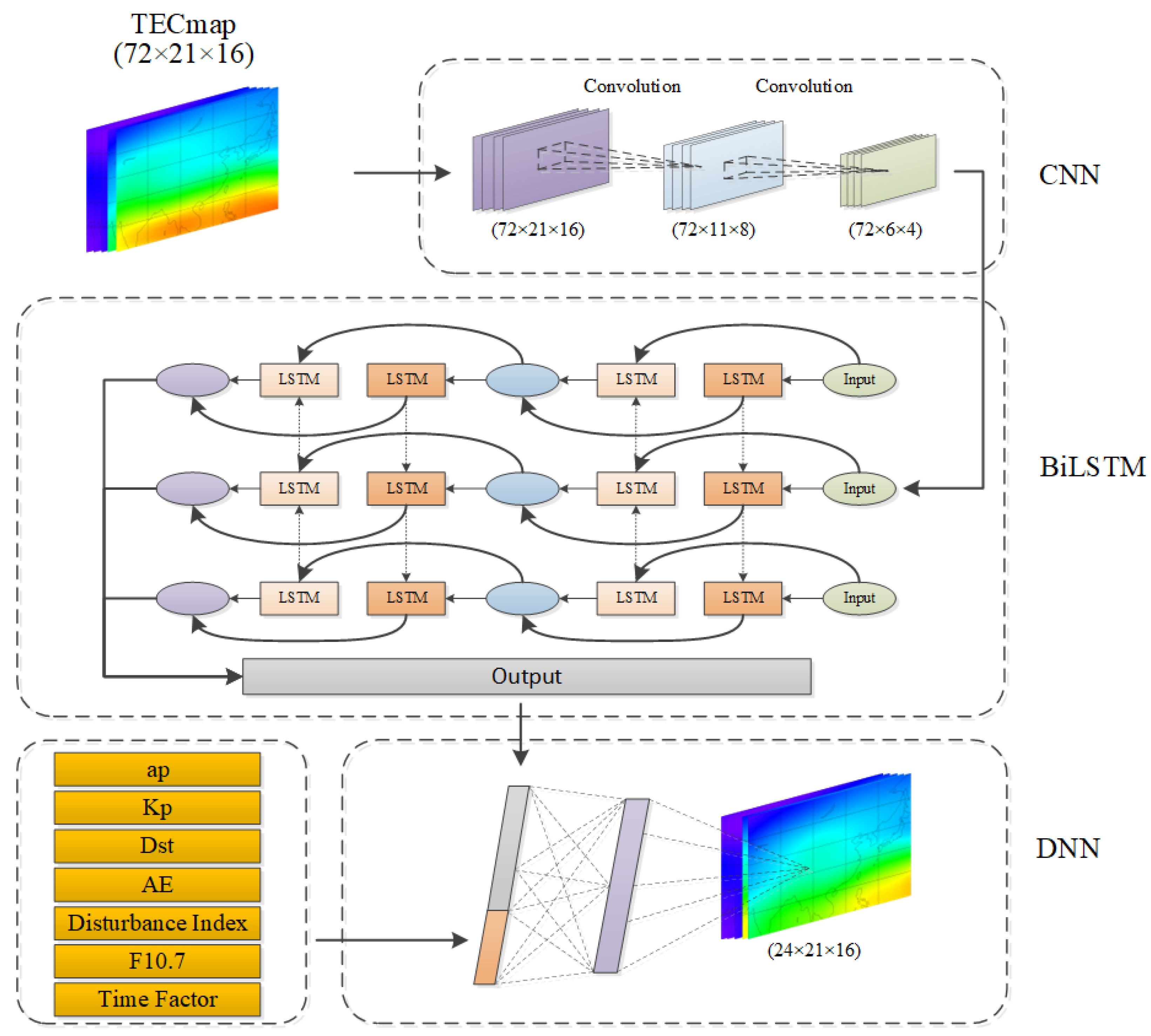
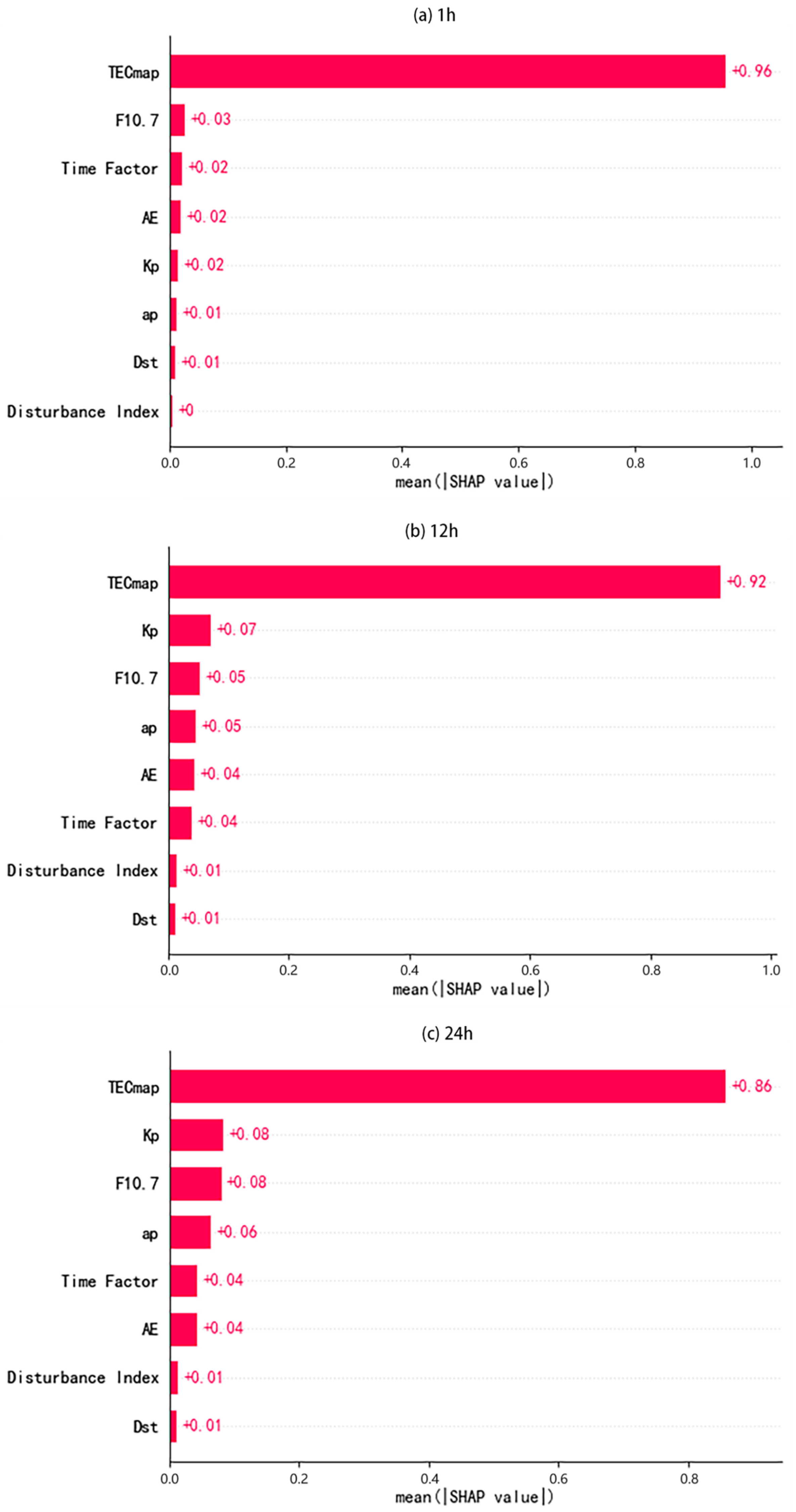
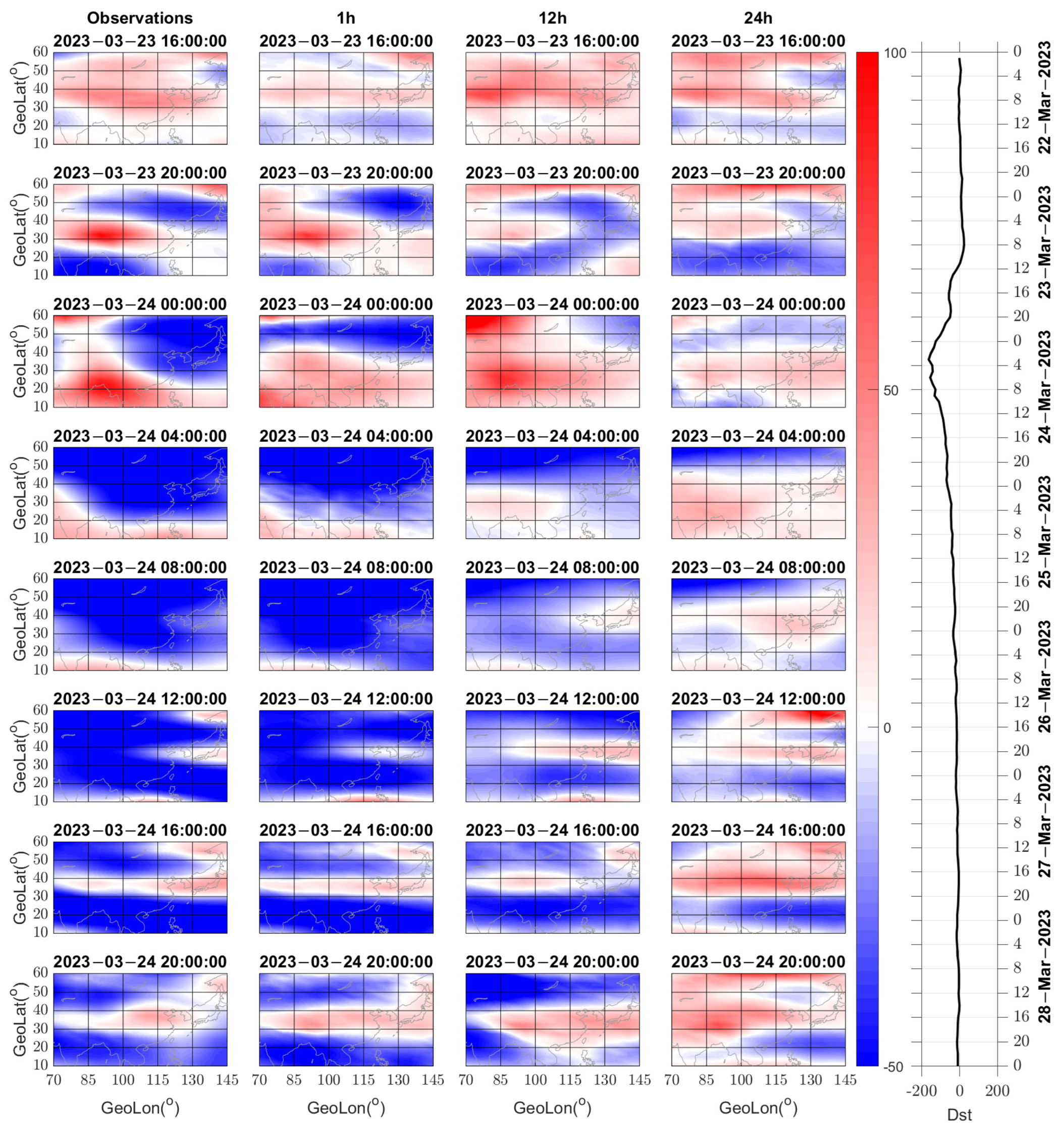

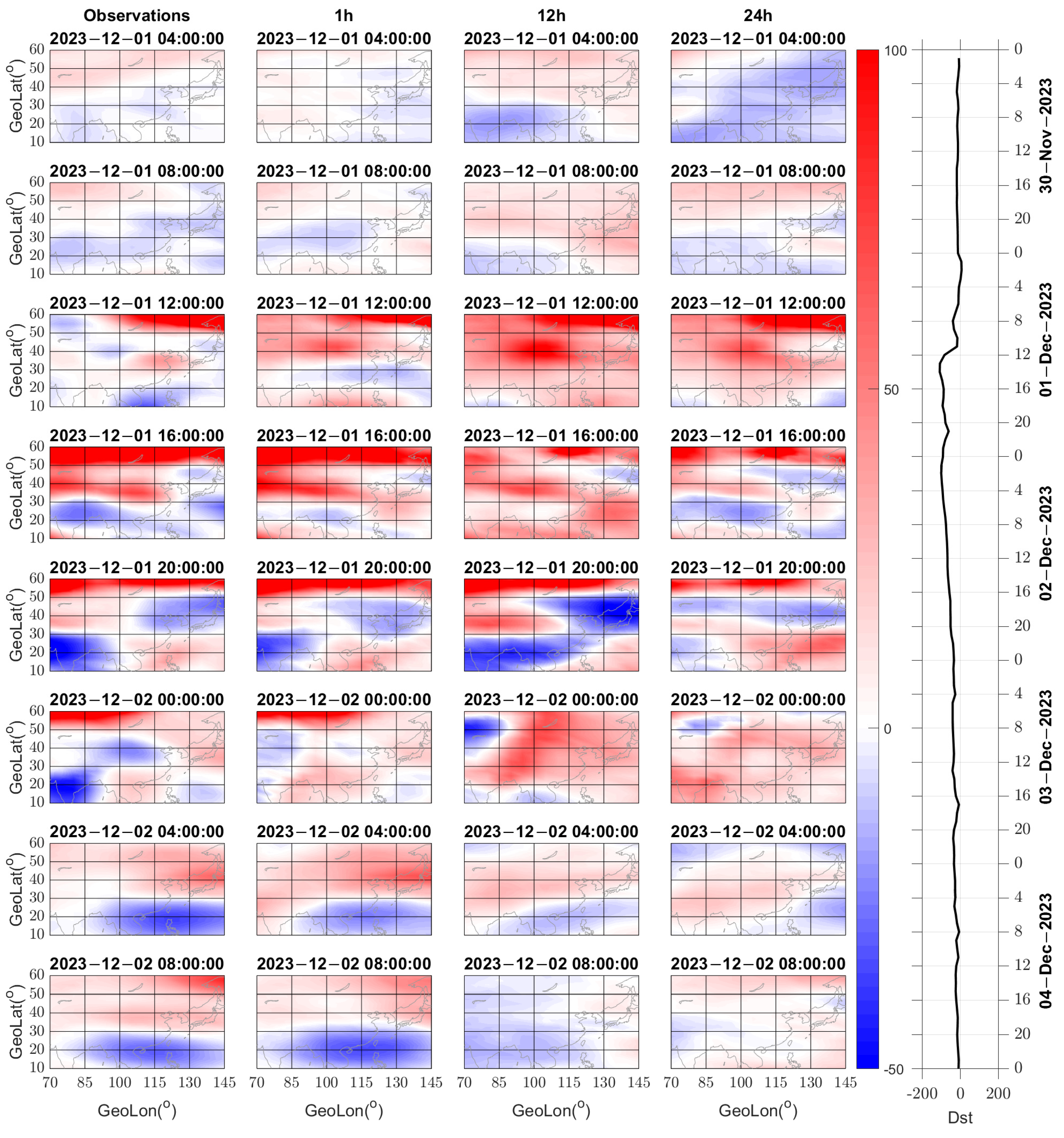
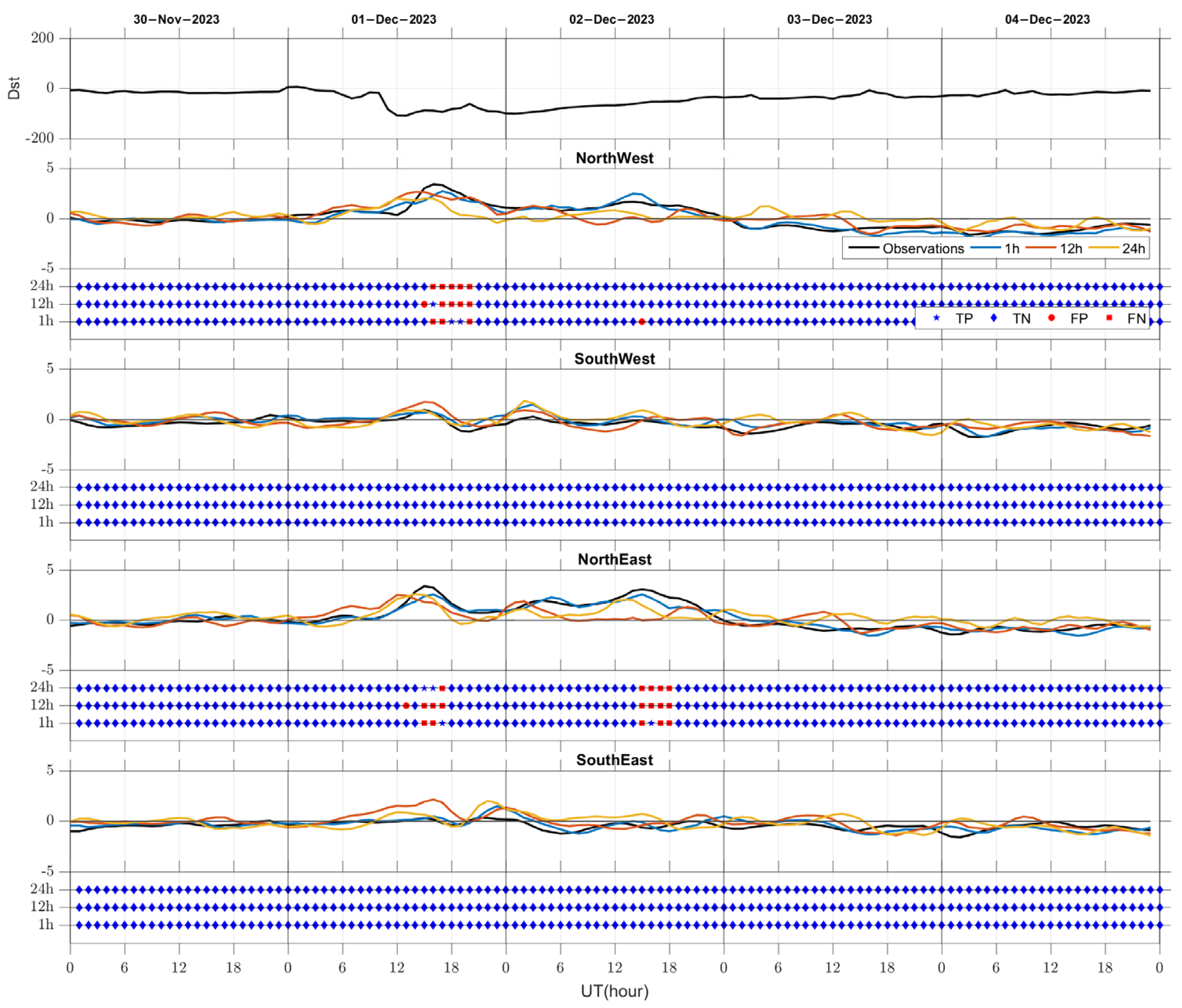
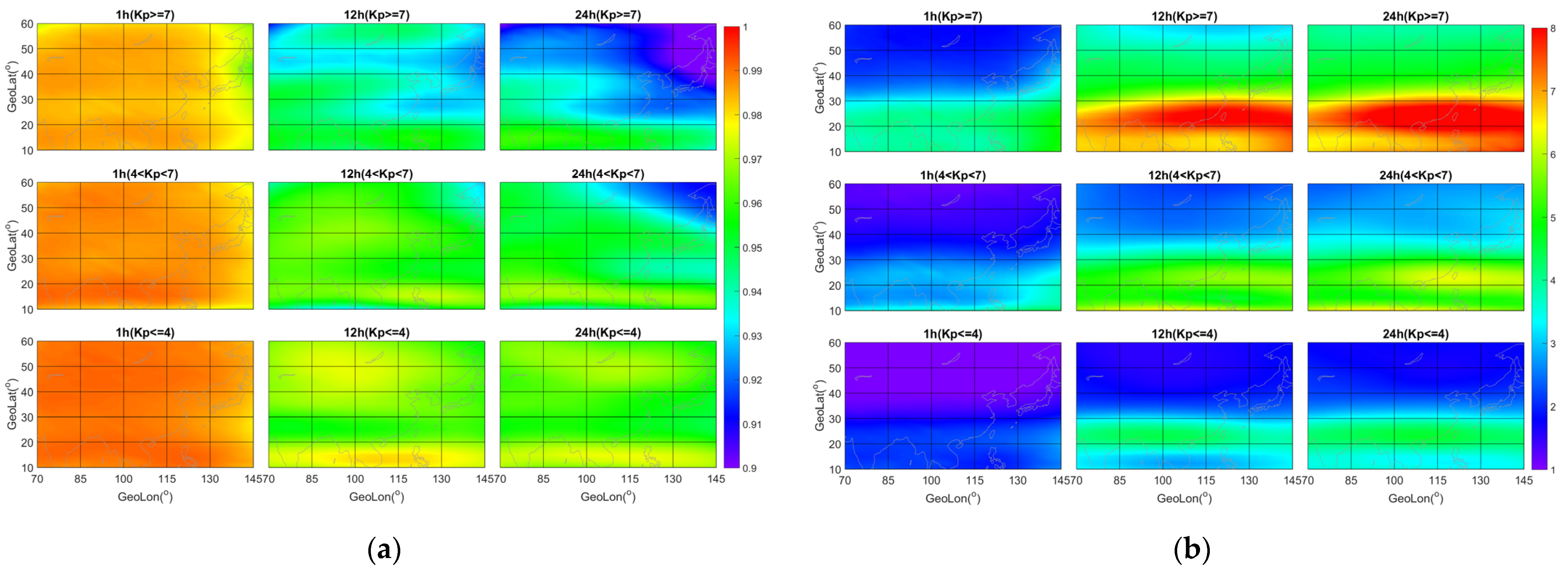
| Storm Level | Definition |
|---|---|
| Strong positive | |
| Median positive | |
| Minor positive | |
| Quiet | |
| Minor negative | |
| Median negative | |
| Strong negative |
| Observed | ||
|---|---|---|
| Predicted | Storm | No Storm |
| Storm | TP (True positive) | FP (False positive) |
| No storm | FN (False negative) | TN (True negative) |
| Predicted Length (h) | Area | Accuracy (%) | Precision (%) | Recall (%) | F1 (%) |
|---|---|---|---|---|---|
| 1 | Northwest | 97.82 | 72.65 | 71.55 | 72.10 |
| Southwest | 98.54 | 69.32 | 50.83 | 58.65 | |
| Northeast | 98.22 | 79.01 | 73.46 | 76.14 | |
| Southeast | 98.40 | 65.22 | 44.30 | 52.76 | |
| Total | 98.25 | 73.40 | 63.99 | 68.37 | |
| 12 | Northwest | 96.58 | 55.72 | 64.01 | 59.58 |
| Southwest | 97.65 | 40.74 | 34.38 | 37.29 | |
| Northeast | 96.96 | 60.89 | 60.09 | 60.49 | |
| Southeast | 97.71 | 41.14 | 31.86 | 35.91 | |
| Total | 97.23 | 53.25 | 52.18 | 52.71 | |
| 24 | Northwest | 96.09 | 50.29 | 56.75 | 53.32 |
| Southwest | 97.09 | 28.45 | 28.33 | 28.39 | |
| Northeast | 96.27 | 51.88 | 51.54 | 51.71 | |
| Southeast | 97.45 | 33.95 | 28.55 | 31.02 | |
| Total | 96.72 | 44.81 | 45.38 | 45.09 |
Disclaimer/Publisher’s Note: The statements, opinions and data contained in all publications are solely those of the individual author(s) and contributor(s) and not of MDPI and/or the editor(s). MDPI and/or the editor(s) disclaim responsibility for any injury to people or property resulting from any ideas, methods, instructions or products referred to in the content. |
© 2024 by the authors. Licensee MDPI, Basel, Switzerland. This article is an open access article distributed under the terms and conditions of the Creative Commons Attribution (CC BY) license (https://creativecommons.org/licenses/by/4.0/).
Share and Cite
Ren, X.; Zhao, B.; Ren, Z.; Xiong, B. Ionospheric TEC Prediction in China during Storm Periods Based on Deep Learning: Mixed CNN-BiLSTM Method. Remote Sens. 2024, 16, 3160. https://doi.org/10.3390/rs16173160
Ren X, Zhao B, Ren Z, Xiong B. Ionospheric TEC Prediction in China during Storm Periods Based on Deep Learning: Mixed CNN-BiLSTM Method. Remote Sensing. 2024; 16(17):3160. https://doi.org/10.3390/rs16173160
Chicago/Turabian StyleRen, Xiaochen, Biqiang Zhao, Zhipeng Ren, and Bo Xiong. 2024. "Ionospheric TEC Prediction in China during Storm Periods Based on Deep Learning: Mixed CNN-BiLSTM Method" Remote Sensing 16, no. 17: 3160. https://doi.org/10.3390/rs16173160
APA StyleRen, X., Zhao, B., Ren, Z., & Xiong, B. (2024). Ionospheric TEC Prediction in China during Storm Periods Based on Deep Learning: Mixed CNN-BiLSTM Method. Remote Sensing, 16(17), 3160. https://doi.org/10.3390/rs16173160







